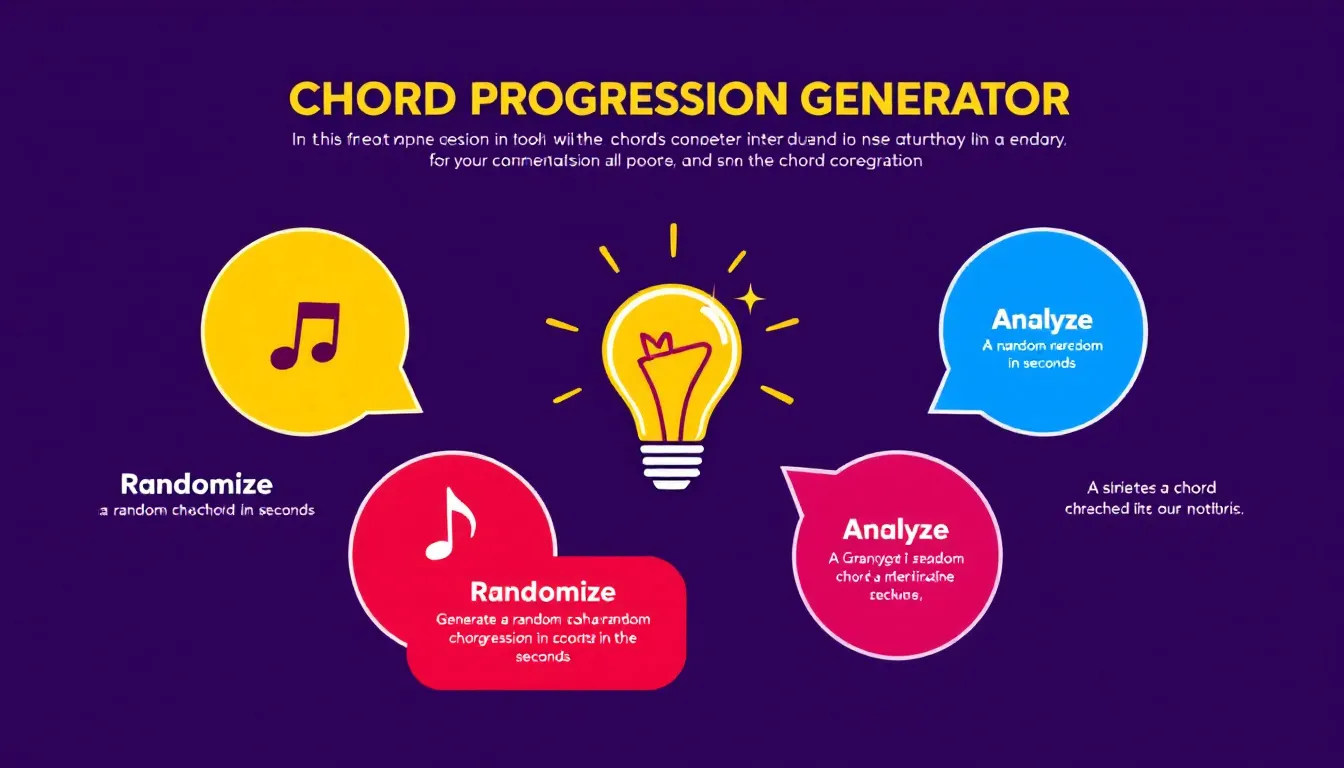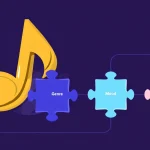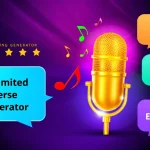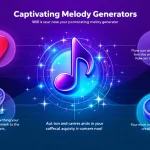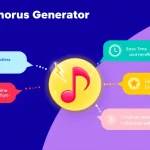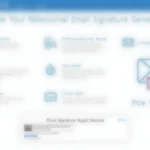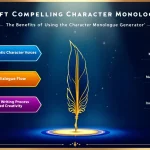Is this tool helpful?
How to Use the Chord Progression Generator Tool Effectively
This chord progression generator helps you craft unique harmonies tailored to specific parts of your song. Follow these steps to get the most out of the tool:
- Type of verse: Enter the section of your song where you want to create chords. For example, try inputs like “intro” or “outro” to specify different parts.
- Mood or emotion of the song: Describe the feeling you want your progression to express. You might input “hopeful” or “somber” to guide the tone.
- Main theme or subject of the song: Provide the central idea or story behind your music, such as “overcoming fear” or “urban nightlife”.
- Genre or style of music (Optional): Add the style to shape the harmony, like “blues” or “synthwave”. This helps tailor the progression but is not required.
- Preferred key signature for the song (Optional): Specify a key, for example “E major” or “D# minor”, if you want the chords centered on a particular scale.
- After filling out the form, click Generate Chord Progression to receive a customized chord sequence designed to fit your inputs.
The tool returns a clear chord progression along with explanations about each chord choice, its sequence, and how it supports the mood and theme you set. You can then copy this progression and use it directly in your songwriting.
What the Chord Progression Generator Does and Why It Matters
This tool lets you create chord progressions that align with your song’s mood, theme, and specific part, such as verse or chorus. By combining your inputs with algorithmic knowledge of music theory, it generates harmonically coherent and emotionally fitting sequences.
Using this generator helps you:
- Break free from repetitive chord sequences and discover fresh harmonic ideas
- Enhance the emotional depth and cohesion of your songs
- Save time by quickly finding musically accurate chord progressions
- Learn about chord relationships through detailed explanations of suggested progressions
How the Generator Creates Meaningful Progressions
Chord progressions are the foundation of harmonic movement in music, shaping how listeners experience tension and resolution. The generator applies well-established music theory principles to balance tension, release, and emotional coloring.
For example, one of the most popular progressions is the I-V-vi-IV. In the key of G major, it looks like this:
G – D – Em – C
This progression moves smoothly between chords, creating a pleasing emotional flow. The generator incorporates such theory and adapts chord choices based on your inputs to create original sequences suited to your song’s mood and theme.
Practical Examples of Using the Chord Progression Generator
1. Calm Acoustic Verse
- Type of verse: Verse
- Mood: Reflective
- Theme: Nature
- Genre: Acoustic
- Key: D major
Suggested progression:
D – Bm – G – A
This sequence uses a warm major key with minor chords to evoke a calm and introspective atmosphere reflecting your song’s natural theme.
2. Energetic Rock Chorus
- Type of verse: Chorus
- Mood: Confident
- Theme: Overcoming challenges
- Genre: Rock
- Key: A minor
Suggested progression:
Am – F – C – G
This progression leverages the minor key’s emotional depth enhanced by strong rock chords to give energy and resolve that fit your empowering message.
3. Dreamy Electronic Bridge
- Type of verse: Bridge
- Mood: Ethereal
- Theme: Space exploration
- Genre: Electronic
- Key: F# minor
Suggested progression:
F#m – C#m7 – B – E
The mix of minor and seventh chords creates a floating feeling, perfect for evoking the mystery and vastness of space in your electronic track.
Common Questions About the Chord Progression Generator
Can I use generated progressions for commercial songs?
Yes, you can freely use the chord progressions created with this tool in your commercial and personal music projects.
How original are the generated chords?
The tool combines your specific inputs with music theory algorithms to produce unique progressions that fit your song’s type, mood, and theme, ensuring fresh and tailored results.
Can I include specific chords in the progression?
Currently, the tool doesn’t accept direct chord inputs but you can modify the generated progressions afterward to include any chords you prefer.
How do I read the chord notation?
Major chords are uppercase letters (e.g., C, G, D), minor chords have an “m” (e.g., Am), slash chords specify bass notes (e.g., G/B), diminished chords appear with “dim” (e.g., F#dim), and seventh chords end with “7” (e.g., D7).
Can the tool generate chords in any key?
Yes, it supports all major and minor keys. If you leave the key field empty, the tool selects the key best suited to your song’s mood and theme.
How can I fit the progression to my melody?
Use the progression as a framework. Feel free to rearrange chords, add or remove them, and adjust rhythms to match your melody and creative style.
Can the tool generate progressions for full songs?
The generator focuses on individual song sections. Generate progressions separately for verses, choruses, bridges, etc., then combine them to build your full song.
Does it work for experimental genres?
Yes. For unique or experimental styles, describe the song’s mood and theme accurately, and you may opt to leave the genre blank to allow more creative freedom in chord suggestions.
Is music theory knowledge required?
No. Anyone can use the tool effectively. Understanding basic music theory helps interpret progressions, but the clear explanations included support users at all levels.
Important Disclaimer
The calculations, results, and content provided by our tools are not guaranteed to be accurate, complete, or reliable. Users are responsible for verifying and interpreting the results. Our content and tools may contain errors, biases, or inconsistencies. Do not enter personal data, sensitive information, or personally identifiable information in our web forms or tools. Such data entry violates our terms of service and may result in unauthorized disclosure to third parties. We reserve the right to save inputs and outputs from our tools for the purposes of error debugging, bias identification, and performance improvement. External companies providing AI models used in our tools may also save and process data in accordance with their own policies. By using our tools, you consent to this data collection and processing. We reserve the right to limit the usage of our tools based on current usability factors.
